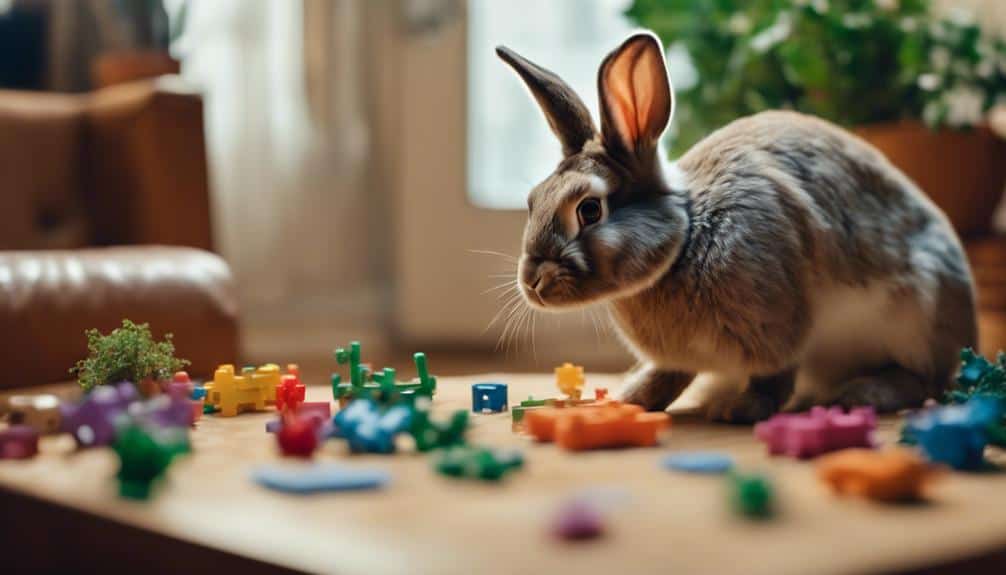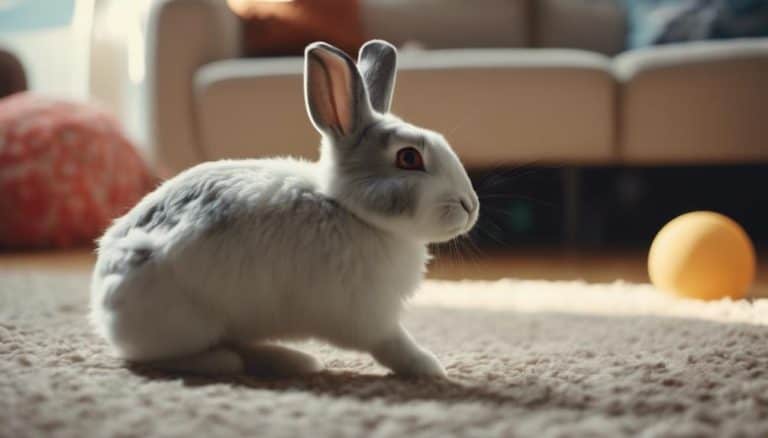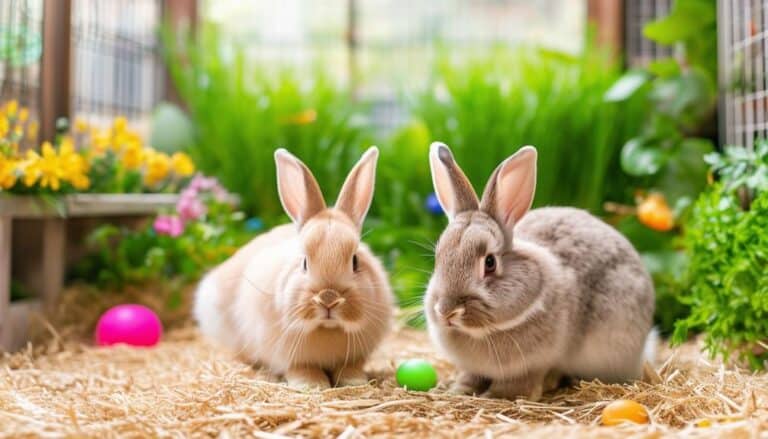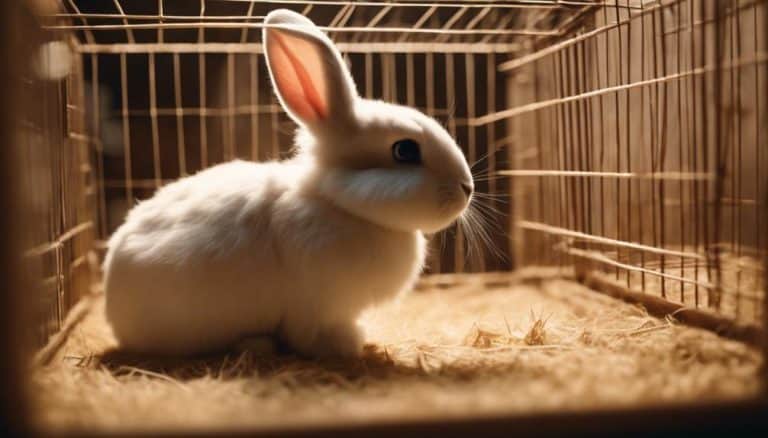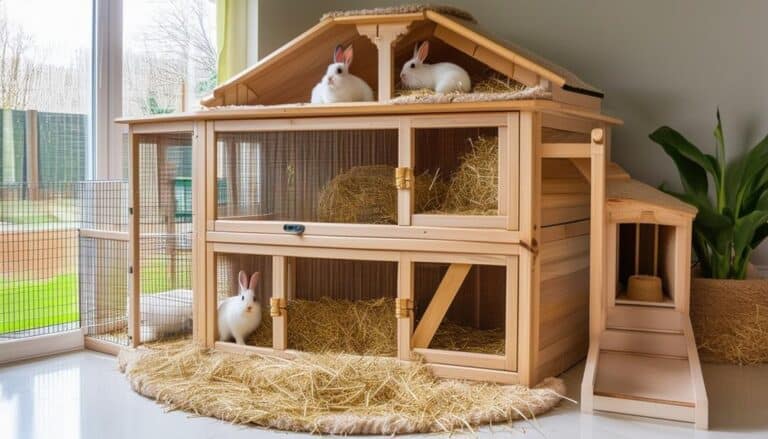Signs of Pet Rabbit Intelligence
You might be surprised to discover just how intelligent your pet rabbit is. These small creatures exhibit remarkable problem-solving skills, quickly figuring out how to navigate puzzles or escape their enclosures.
Their cognitive abilities extend to learning from past experiences, easily memorizing pathways, and adapting to changes in their environment. Socially, they engage in complex behaviors like reciprocal grooming and establishing hierarchies, proving they understand and respond to social signals. And that’s just scratching the surface—there’s much more to uncover about their learning and communication methods.
Problem-Solving Skills
How do rabbits demonstrate their problem-solving skills through their ability to navigate mazes and solve puzzles? When you provide a rabbit with a maze or a puzzle, you’re tapping into their innate problem-solving skills. These animals can be trained to understand and manipulate their environment, such as learning to open latches or escape enclosures. This isn’t just a random act; it’s an evidence-based demonstration of their cognitive abilities.
Rabbits exhibit a remarkable capacity to locate hidden treats, which underscores their intelligence and adaptability. Interactive toys and challenges aren’t just important; they’re essential for engaging your rabbit’s mental agility. These activities require them to analyze their surroundings, understand cause and effect, and adapt to new situations—skills that are crucial for problem-solving.
Moreover, by observing how rabbits navigate obstacles, you can see their ability to learn from experiences and apply this knowledge in future scenarios. This adaptive learning showcases their cognitive capabilities in a tangible way. Providing these challenges not only enriches their environment but also enhances their mental wellbeing, giving them the freedom to express their natural problem-solving skills fully.
Social Interactions
Rabbits demonstrate their social intelligence through behaviors like reciprocal grooming, thumping, and establishing social hierarchies. Reciprocal grooming is a key indicator of social bonding. When your rabbit grooms you or another rabbit, it’s not just about hygiene—it’s a deliberate act to solidify social connections. This behavior underscores their ability to form complex social structures.
Thumping serves as a multifaceted communication tool. In the wild, rabbits thump to warn others of danger, but domesticated rabbits may thump to express displeasure or seek attention, showcasing their awareness of social dynamics. Recognizing these signals in your rabbit can greatly enhance your ability to meet their social needs.
Establishing social hierarchies is also a critical aspect of their social intelligence. Rabbits will assert dominance through mounting or nudging, creating a clear social order within their group. This hierarchy is essential for maintaining peace and reducing conflict among cohabitating rabbits.
Understanding these behaviors allows you to create a more enriching environment for your pet. By recognizing and responding to their social intelligence, you’re fostering a stronger bond and ensuring their psychological well-being. This evidence-based approach will help you cultivate a harmonious living space for your rabbit.
Environmental Adaptability
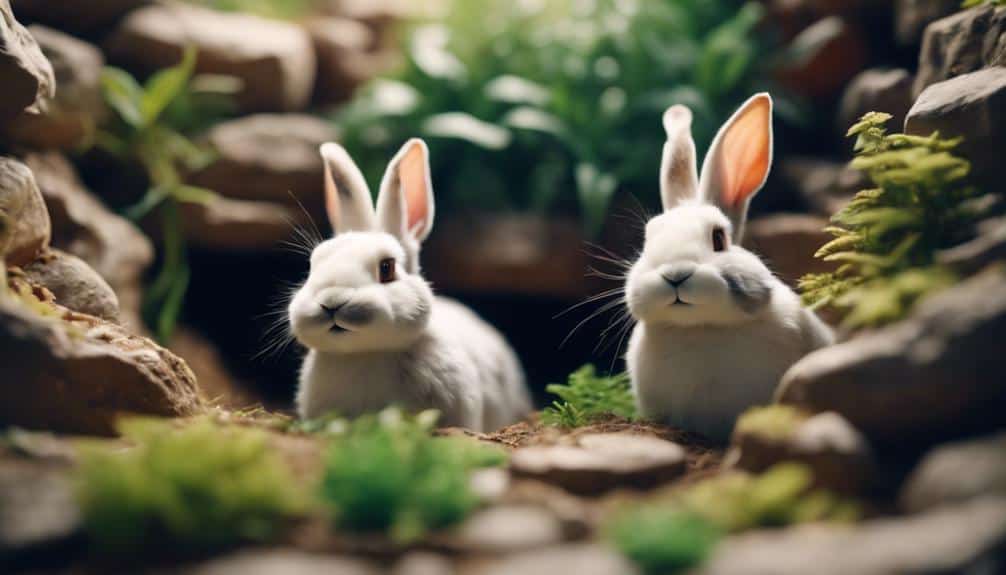
You’ll observe your rabbit’s intelligence through its capacity for environmental adaptability, reflected in its ability to learn new habits swiftly.
This adaptability encompasses moving through home spaces efficiently and employing quick problem-solving skills to overcome obstacles.
Such behaviors indicate not only cognitive flexibility but also robust survival instincts.
Learning New Habits
When pet rabbits encounter new environments, they quickly demonstrate cognitive flexibility by learning and adapting to new habits and routines. This remarkable capacity for learning new habits is a strong indicator of their environmental adaptability, showcasing their cognitive prowess and behavioral plasticity.
Your rabbit’s ability to adjust to changes in their living space and develop new routines isn’t only vital but also evidence-based. Studies have shown that rabbits exhibit advanced problem-solving skills when faced with unfamiliar situations. For instance, they can learn to navigate around obstacles, find new food sources, and even respond to changes in their environment with altered behaviors. This adaptability is essential for their survival and well-being, reflecting an intrinsic intelligence that many pet owners may overlook.
Moreover, rabbits’ quick adaptation to environmental changes highlights their ability to interact with diverse stimuli. They can learn to associate specific cues with rewards or consequences, further showcasing their capacity for behavioral conditioning.
Navigating Home Spaces
Frequently, pet rabbits exhibit their cognitive prowess by efficiently memorizing and finding safe pathways within their home environments. These animals employ their memory skills to traverse familiar areas, demonstrating an impressive level of environmental adaptability. When you observe your rabbit, you’ll notice their ability to recognize specific locations and navigate changes in their surroundings with ease. This behavior isn’t just significant—it’s a validation of their cognitive capabilities.
Research indicates that rabbits rely heavily on spatial memory to navigate their living spaces. Once they’ve memorized safe pathways, they can quickly return to their preferred resting spots or food sources. This memorization process involves complex neural mechanisms, reflecting their innate intelligence and survival instincts. By effectively remembering and utilizing safe pathways, your rabbit showcases an advanced understanding of their environment.
Moreover, adaptability to environmental changes further underscores a rabbit’s intellectual acumen. If you rearrange their living space, they’ll promptly adjust, relearning safe routes and avoiding obstacles. This adaptability is vital for their well-being and safety, ensuring they can avoid potential hazards.
Understanding your rabbit’s ability to memorize and navigate their home spaces not only highlights their intelligence but also enhances your appreciation of their unique cognitive skills.
Quick Problem Solving
Building on their ability to maneuver through home spaces, pet rabbits also exhibit remarkable quick problem-solving skills, effectively adapting to new environments and challenges. This cognitive flexibility is evident when they figure out how to escape enclosures, analyze spatial problems, and overcome obstacles. Rabbits’ problem-solving abilities are not just limited to escaping; they also excel at discovering hidden treats, demonstrating a keen ability to engage with their environment dynamically.
| Problem-Solving Skill | Example | Evidence of Intelligence |
|---|---|---|
| Escaping Enclosures | Finding weak spots in cages or barriers | Spatial Analysis |
| Overcoming Obstacles | Maneuvering through complex setups | Cognitive Flexibility |
| Discovering Hidden Treats | Locating food in hidden spots | Environmental Engagement |
These behaviors underscore their mental acuity and the ability to adapt rapidly. When you observe your rabbit solving problems, you’re witnessing their intelligence and mental capabilities in action. Their adaptability to different environments and situations not only highlights their problem-solving skills but also their overall cognitive sophistication. This adaptability and intelligence are vital for their well-being, especially in varying domestic settings. Understanding these traits can enhance your appreciation of their complex mental lives and their need for stimulating environments.
Memory and Recognition
Rabbits exhibit remarkable memory and recognition skills, enabling them to navigate familiar environments and identify individuals through scent, voice, and appearance. Their memory capabilities are evident when they recall safe pathways and specific locations, ensuring they can find their way back home efficiently. This spatial memory is vital for their survival, as it allows them to avoid predators and locate food sources.
Moreover, rabbits form strong bonds with humans, recognizing familiar individuals by scent, vocal cues, and visual appearance. This recognition extends beyond mere familiarity; it involves an emotional connection that can greatly impact their behavior and well-being. Positive interactions foster trust and affection, while negative experiences are vividly remembered, influencing their future interactions and trust levels.
Understanding these advanced memory and recognition abilities is essential for enhancing the human-rabbit bond. By acknowledging their capacity to remember and recognize, you can create a more enriching and secure environment for your pet. This knowledge empowers you to interact with them in ways that reinforce positive memories and minimize stress, thereby promoting their emotional well-being and strengthening your relationship with them.
Communication Methods
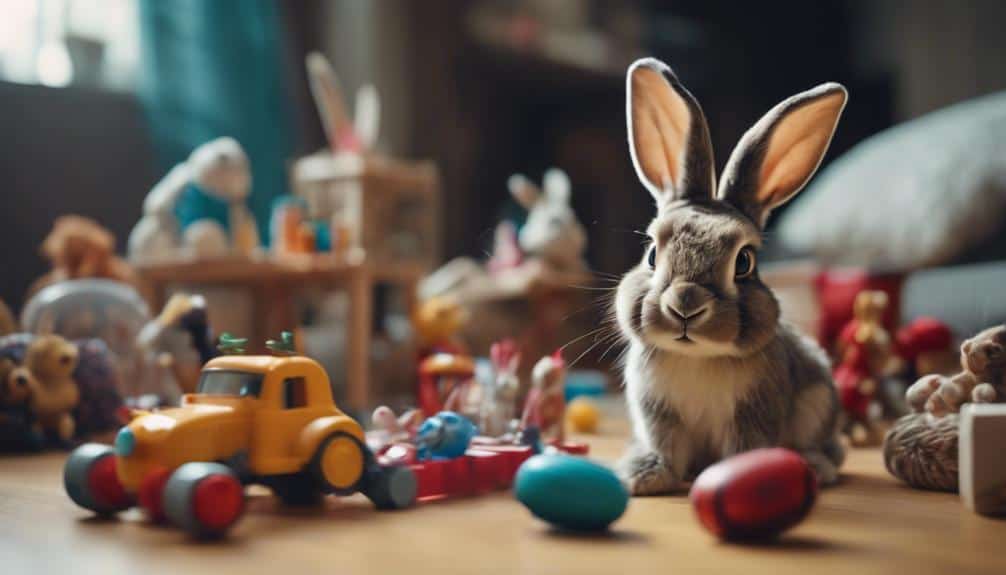
Understanding rabbits’ memory and recognition skills also necessitates examining their complex communication methods, which involve a blend of vocalizations, body language, and non-verbal cues. Rabbit behavior is multifaceted, and recognizing these elements is essential for effective interaction.
Sounds such as purring indicate contentment, while grunting often signals frustration or displeasure. Teeth grinding can denote either comfort or pain, depending on the context.
Body language is a significant component of rabbit communication. Ear position provides insights into their emotional state—upright ears suggest alertness, whereas flattened ears may indicate fear or submission. Thumping serves as a warning signal, while grooming interactions can signify social bonding and hierarchy establishment.
Vocalizations like squealing, honking, and growling are critical for expressing acute emotions such as fear, pain, or discomfort. These sounds are less common but important for understanding urgent needs. Additionally, tail movements, direct eye contact, and specific body postures serve as essential non-verbal communication methods, further illustrating the depth of rabbit behavior.
Comprehending these nuances helps strengthen the bond between you and your rabbit, enabling a more profound and empathetic connection. This understanding empowers you to respond appropriately to their needs and emotions, fostering a harmonious relationship.
Learning and Training
When training your rabbit, you’ll notice their capacity for mastering simple tricks, which indicates significant cognitive function.
Their problem-solving skills become evident as they interact with puzzle toys or work to escape enclosures.
These behaviors underscore the importance of mental engagement through structured learning activities for your rabbit’s overall well-being.
Simple Trick Mastery
Training your pet rabbit to master simple tricks like jumping through hoops or running an agility course demonstrates their cognitive capabilities and responsiveness to consistent, structured training. Engaging in training sessions with your rabbit leverages evidence-based methods like clicker training and positive reinforcement, utilizing verbal cues or hand signals. These sessions not only showcase your rabbit’s ability to learn but also strengthen the human-animal bond.
Rabbits can be trained to execute a variety of tricks, such as spinning in a circle, standing on their hind legs, or nudging a ball with their nose. These activities provide essential mental stimulation, enhancing both their cognitive abilities and overall well-being. During training sessions, it’s important to maintain consistency and patience, rewarding desired behaviors promptly to reinforce learning.
Studies have shown that rabbits respond well to structured environments where there’s clear communication and predictable outcomes. This structured approach allows them to exhibit problem-solving prowess and adaptability. By keeping the training sessions engaging and varied, you make certain that your rabbit remains mentally stimulated and enthusiastic to learn.
Mastering simple tricks is a clear indicator of your rabbit’s intelligence and adaptability.
Problem-Solving Skills
Observing your rabbit’s ability to solve puzzle toys and escape enclosures underscores their sophisticated problem-solving skills and adaptability. Such behaviors provide concrete evidence of their cognitive capabilities and learning potential. When you offer daily pellets in treat dispenser balls, you not only encourage physical exercise but also stimulate their mental faculties, enhancing their problem-solving skills.
Rabbits exhibit a remarkable level of cognitive flexibility. They develop strategies to tackle unfamiliar toys, adjusting their approach based on their experiences and environmental interactions. Their ability to learn and understand human words and hand signals further highlights their intelligence and adaptability in a domesticated setting.
Here’s a table to illustrate key aspects of rabbit problem-solving skills:
| Behavior | Description | Significance |
|---|---|---|
| Solving Puzzle Toys | Finding treats in complex toys | Demonstrates cognitive skills |
| Escaping Enclosures | Finding ways out of barriers | Shows adaptability |
| Learning Tricks | Performing actions on command | Indicates learning capability |
| Using Treat Dispensers | Extracting food from dispenser balls | Enhances mental engagement |
| Understanding Signals | Responding to human words and gestures | Highlights communication skills |
These behaviors collectively underscore your rabbit’s problem-solving skills, showcasing their intellectual depth and adaptability. By engaging them in mentally stimulating activities, you foster their cognitive growth and overall well-being.
Emotional Intelligence
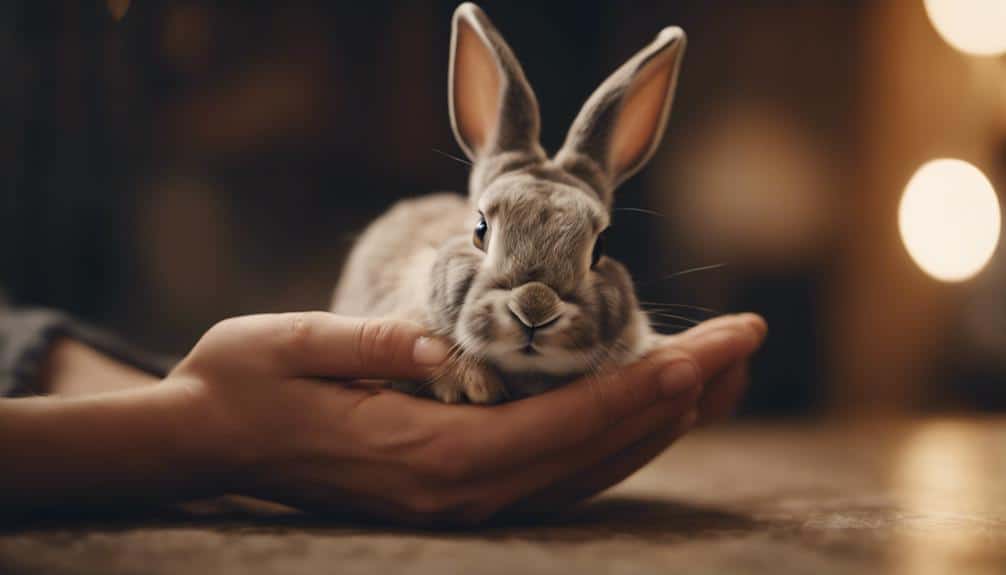
Pet rabbits exhibit a high level of emotional intelligence, manifesting through a spectrum of emotions such as affection, jealousy, anger, and curiosity. Their mental capabilities allow them to recognize their owners by scent and voice, forming strong bonds and demonstrating loyalty and affection. Understanding these nuances is essential for maintaining their overall well-being and happiness.
Rabbits can exhibit a wide range of emotions, including happiness, sadness, fear, dominance, satisfaction, restlessness, and boredom. These emotional states can be observed through their body language and behaviors. For instance, a happy rabbit might binky, while a fearful one could exhibit thumping or hiding behaviors. Recognizing these signs allows you to address their needs effectively.
Building a strong bond through training and interaction is crucial. Engaging in activities that stimulate their emotional and mental capabilities can significantly enhance their emotional well-being. Providing a variety of toys, regular social interaction, and a stable environment helps prevent negative emotions such as restlessness and boredom.
Ultimately, by catering to your rabbit’s emotional needs, you’ll not only improve their quality of life but also strengthen the human-rabbit relationship, fostering a deeper, more fulfilling connection.
Conclusion
You’ve seen how pet rabbits exhibit problem-solving skills, social interactions, and environmental adaptability. Their memory and recognition capabilities, along with diverse communication methods, further highlight their intelligence.
Training and learning adaptability underscore their cognitive flexibility. By understanding these intricate behaviors, you’re better equipped to provide an enriching environment, fostering their mental and emotional well-being.
This evidence-based approach guarantees your rabbit’s best health and happiness, reflecting their sophisticated cognitive and emotional capacities.

